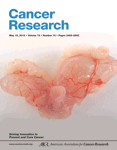Nature:雄激素抵抗性前列腺癌研究获新进展
2012-05-24 mili 生物谷
在临床上,治疗前列腺癌的首选方法是抑制体内雄激素水平。但在经过一段时间的激素治疗,病情经历一个停滞期后,多数患者对于激素治疗开始变得不敏感,转变为雄激素抵抗性的前列腺癌(castration-resistant prostate cancer,CRPC),目前临床上对于这种情况仍没有有效的治疗措施。 通过对前列腺癌转录组和基因组特征的研究发现,在前列腺癌细胞中,存在着染色体重排,基因拷贝数增加或
在临床上,治疗前列腺癌的首选方法是抑制体内雄激素水平。但在经过一段时间的激素治疗,病情经历一个停滞期后,多数患者对于激素治疗开始变得不敏感,转变为雄激素抵抗性的前列腺癌(castration-resistant prostate cancer,CRPC),目前临床上对于这种情况仍没有有效的治疗措施。
通过对前列腺癌转录组和基因组特征的研究发现,在前列腺癌细胞中,存在着染色体重排,基因拷贝数增加或减少等异常现象。包括ETS家族基因融合、PTEN缺失和雄激素受体(androgen receptor, AR)扩增等。这些染色体异常会促进前列腺癌的发展,并最终形成致死的雄激素抵抗性前列腺癌。但是基因突变在前列腺癌的发展中扮演着怎样的角色,目前我们还知之甚少。
本文中,作者对50个接受过重度激素治疗的转移性CRPC样本(其中有3个是来自同一患者的不同病变组织)和11个轻度激素治疗的局部前列腺癌样本进行外显子组测序比较。研究者找到了致死性CRPC的单克隆起源,并发现即使在重度激素治疗的CRPC中,突变的频率也是很低的。外显子拷贝数分析显示,在一类前列腺癌细胞中存在着CHD1的缺失,研究者据此定义了一个新的EST-前列腺癌亚型。而EST2在前列腺癌细胞中的异常表现为融合缺失和突变两种情况。此外,研究者还鉴定了在多条染色质上出现的频发突变和组蛋白修饰基因,其中包括编码H3K4甲基转移酶的特异基因MLL2(在8.6%的前列腺癌中发生突变)。MLL2复合体能够与AR相互作用,这种作用在AR介导的信号通路中是必需的。同时,研究者也检测了FOXA1的异常频发突变,FOXA1是能与AR协同作用的因子,在147个样本中,有5个样本的FOXA1发生了突变。FOXA1的突变会抑制雄激素途径,并促进肿瘤的生长。在一些与AR直接相互作用的蛋白,比如ERG基因融合产物、FOXA1、MLL2、UTX和ASXL1中均检测到了突变。
简而言之,通过对于雄激素抵抗性前列腺癌的突变位点进行分析,有助于了解AR信号通路在前列腺癌发展中是如何变得不受控制的。同时该项研究的结果也能为前列腺癌的后续研究提供候选基因

doi:10.1038/nature11125
PMC:
PMID:
The mutational landscape of lethal castration-resistant prostate cancer
Catherine S. Grasso, Yi-Mi Wu, Dan R. Robinson,Xuhong Cao, Saravana M. Dhanasekaran, Amjad P. Khan, Michael J. Quist, Xiaojun Jing, Robert J. Lonigro, J. Chad Brenner, Irfan A. Asangani, Bushra Ateeq, Sang Y. Chun, Javed Siddiqui, Lee Sam, Matt Anstett, Rohit Mehra, John R. Prensner, Nallasivam Palanisamy, Gregory A. Ryslik, Fabio Vandin, Benjamin J. Raphael, Lakshmi P. Kunju, Daniel R. Rhodes, Kenneth J. Pienta, Arul M. Chinnaiyan & Scott A. Tomlins et al. .
Characterization of the prostate cancer transcriptome and genome has identified chromosomal rearrangements and copy number gains and losses, including ETS gene family fusions, PTEN loss and androgen receptor (AR) amplification, which drive prostate cancer development and progression to lethal, metastatic castration-resistant prostate cancer (CRPC)1. However, less is known about the role of mutations2, 3, 4. Here we sequenced the exomes of 50 lethal, heavily pre-treated metastatic CRPCs obtained at rapid autopsy (including three different foci from the same patient) and 11 treatment-naive, high-grade localized prostate cancers. We identified low overall mutation rates even in heavily treated CRPCs (2.00 per megabase) and confirmed the monoclonal origin of lethal CRPC. Integrating exome copy number analysis identified disruptions of CHD1 that define a subtype of ETS gene family fusion-negative prostate cancer. Similarly, we demonstrate that ETS2, which is deleted in approximately one-third of CRPCs (commonly through TMPRSS2:ERG fusions), is also deregulated through mutation. Furthermore, we identified recurrent mutations in multiple chromatin- and histone-modifying genes, including MLL2 (mutated in 8.6% of prostate cancers), and demonstrate interaction of the MLL complex with the AR, which is required for AR-mediated signalling. We also identified novel recurrent mutations in the AR collaborating factor FOXA1, which is mutated in 5 of 147 (3.4%) prostate cancers (both untreated localized prostate cancer and CRPC), and showed that mutated FOXA1 represses androgen signalling and increases tumour growth. Proteins that physically interact with the AR, such as the ERG gene fusion product, FOXA1, MLL2, UTX (also known as KDM6A) and ASXL1 were found to be mutated in CRPC. In summary, we describe the mutational landscape of a heavily treated metastatic cancer, identify novel mechanisms of AR signalling deregulated in prostate cancer, and prioritize candidates for future study.
本网站所有内容来源注明为“梅斯医学”或“MedSci原创”的文字、图片和音视频资料,版权均属于梅斯医学所有。非经授权,任何媒体、网站或个人不得转载,授权转载时须注明来源为“梅斯医学”。其它来源的文章系转载文章,或“梅斯号”自媒体发布的文章,仅系出于传递更多信息之目的,本站仅负责审核内容合规,其内容不代表本站立场,本站不负责内容的准确性和版权。如果存在侵权、或不希望被转载的媒体或个人可与我们联系,我们将立即进行删除处理。
在此留言














#抗性#
83
#Nat#
56